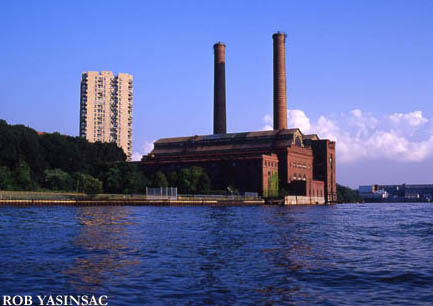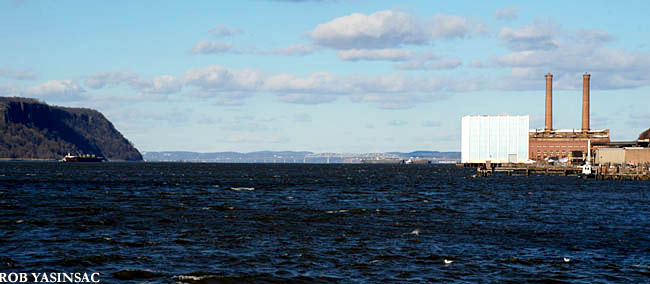NEW YORK CENTRAL AND HUDSON RIVER RAILROAD

YONKERS POWER STATION
NEW YORK CENTRAL AND HUDSON RIVER RAILROAD

YONKERS POWER STATION
NAMED TO SEVEN TO SAVE LIST
Preservation
League of New York State Continues Listing Most Endangered Places for 2008
ALBANY, January 30, 2008
– The Preservation League of New York State has named the former Glenwood
Power Station in Yonkers, Westchester County, to the nonprofit
group’s annual list of the Empire State’s most threatened historic
resources, Seven to Save.
The
Yonkers Power Station, begun as part of the New York Central and Hudson River
Railroad in 1904, stands as a monument to early 20th-century engineering and the
New York Central Railroad electrification that led to the suburban growth of
Westchester County. The architects for the Yonkers Power
Station were Charles Reed and Allen Stem, who, along with Warren and Wetmore,
also designed Grand Central Terminal.
“Even
this impressive pedigree did not prevent another Reed and Stem Power Station –
According
to Hudson Valley Ruins: Forgotten Landmarks of an American Landscape,
a book co-authored by Tom Rinaldi and Rob Yasinsac:
When
completed, the Yonkers Power Station stood as a triumphant expression of the
architecture and engineering of its day … built of red brick, with rows of
monumental arched windows, red terracotta trim and corbelled cornices. [The
plant closed in 1963,] dwarfed by newer and more efficient power plants in New
York and farther up the Hudson. Now, more than forty years
after it closed, the Yonkers Power Station remains abandoned, a hulking
industrial ruin facing out across the river toward the cliffs of the palisades.
“After
decades of abandonment, it has become arguably the most noteworthy and dramatic
ruin, industrial or other, on the Hudson River,” said Yasinsac. “The
historian Roger Panetta used the power station in Bill Moyer’s 2003 PBS
special on the river to illustrate not only the decline of industry on the
Hudson, but more importantly to show an example of the kind of landmark now
threatened by decay and by growing pressure to redevelop the river’s long
neglected shoreline.”
The
City of Yonkers Landmarks Preservation Board unanimously recommended this
building for local designation in 2005 but the Yonkers City Council has not
acted on the proposed landmark designation. The building’s owner is actively
marketing the site for redevelopment while the building remains unprotected.
“As
metropolitan waterfronts are redeveloped, we are losing the magnificent power
plants that made our modern transportation systems possible,” said
Mary Habstritt, Chair of the Preservation Committee of the Roebling Chapter,
Society for Industrial Archeology. “The Yonkers Power
Station is one of the most architecturally beautiful of those left to us.
It is a worthy reminder of the New York Central Railroad, once called ‘The
Greatest Highway in the World’ and the ‘Life Line of New York.’”
The
Preservation League and advocates are calling for local landmark designation to
move forward, and pledges to work with stakeholders on reuse plans that respect
the building’s industrial character and architectural and engineering
integrity.
“Throughout
the world, other historic power stations have been successfully adapted to house
everything from museums, such as the Tate Modern in London and the Centrale
Montemartini in Rome, to shopping centers, such as ‘The Powerplant’ in
Baltimore’s Inner Harbor,” said Erin Tobin, the League’s Regional Director
of Technical and Grant Programs for eastern New York. “We must ensure that
this and other historic industrial structures, so important to the Hudson
Valley’s character and cultural identity, continue to play an important role
in life along the river.”
Since
1999, publicity surrounding the Seven to Save designation has led
to the stabilization of St. Joseph’s Church in Albany, the
rehabilitation of the Oswego City Public Library, and prevented the
demolition of the Conger Goodyear House on Long Island, along with
successes at several other locations.
Two
additional Seven to Save announcements will be made around the state in
early 2008. The Prospect Hill-Columbus Park neighborhood in Buffalo, Erie
County, Holy Trinity Monastery in Herkimer County, Jones Beach State Park in
Nassau County, and the historic Saratoga Race Course in Saratoga County have
already been designated.
The
Preservation League of New York State, founded in 1974, is a not-for-profit
organization dedicated to the protection of New York’s diverse and rich
heritage of historic buildings, districts and landscapes. From its headquarters
in Albany, it provides a unified voice for historic preservation. By leading a
statewide movement and sharing information and expertise, the Preservation
League of New York State promotes historic preservation as a tool to revitalize
the Empire State’s neighborhoods and communities.
Media
Coverage
"Yonkers' Glenwood Power Station put on "Most Endangered
Places" list," byErnie Garcia, The Journal News. January 30, 2008

MORE YONKERS POWER STATION
Hudson
Valley Ruins - Tom Rinaldi Hudson
Valley Ruins - Rob Yasinsac
Yonkers
Power Station - News Updates